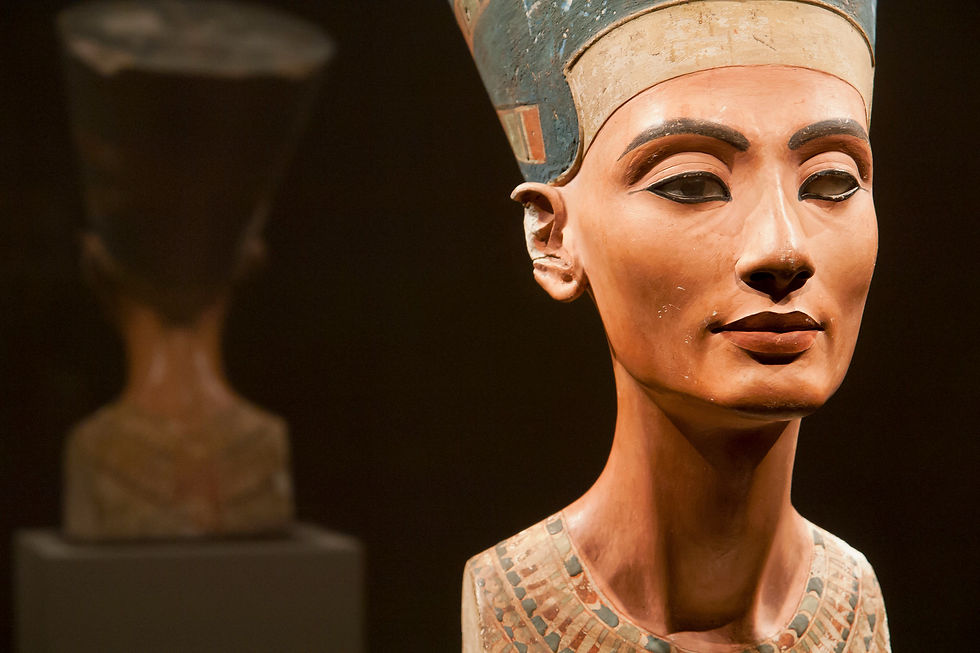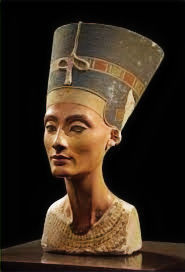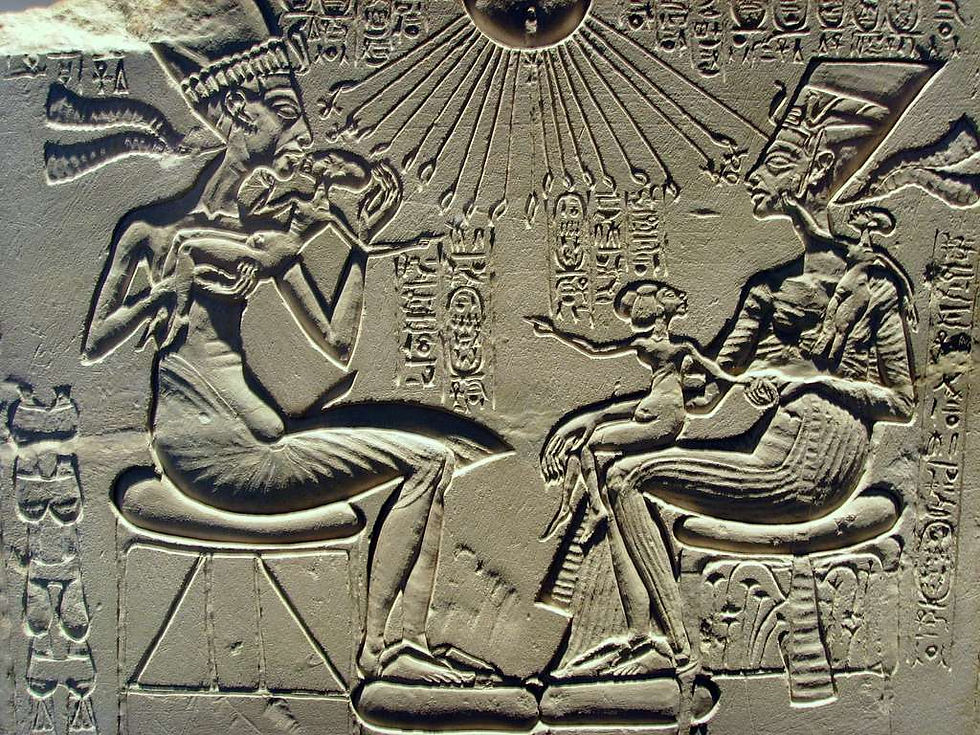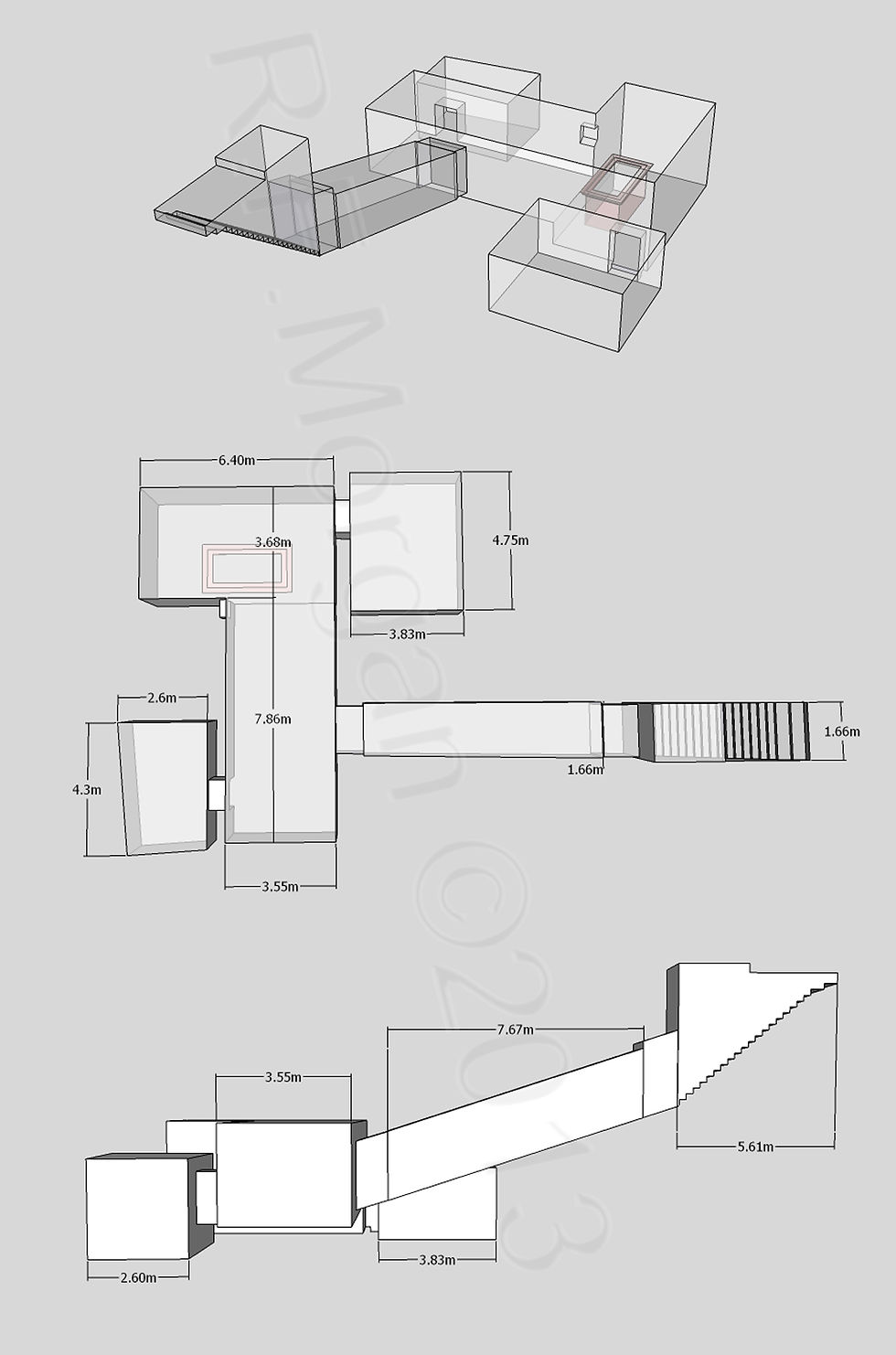Nefertiti’s Hidden Legacy
- Windfarer

- Aug 15
- 4 min read
Updated: Aug 18
Secrets Behind Tutankhamun’s Tomb Walls?
By Windfarer, August 15, 2025

Prologue
Picture Howard Carter’s awe in 1922, gazing into Tutankhamun’s tomb, where golden treasures gleamed after 3,000 years. Now imagine a secret door in those walls, hiding Queen Nefertiti, Egypt’s most enigmatic ruler. Her iconic bust, with its serene blue crown, captivates the world, yet her tomb remains lost. In 2015, Egyptologist Nicholas Reeves unveiled a thrilling theory: Tutankhamun’s KV62 conceals chambers built for Nefertiti, possibly as Pharaoh Neferneferuaten. Backed by cutting-edge scans and hieroglyph clues, this hypothesis reveals the Egyptians’ genius for hiding sacred spaces. From KV62’s odd layout to artifacts whispering Nefertiti’s name, join us to uncover a mystery that could rival Carter’s discovery.

Nefertiti’s bust glowing softly in a museum case
The Queen Who Shaped an Era
Nefertiti, meaning “the beautiful one has come,” was a pivotal figure in Egypt’s 18th Dynasty (ca. 1370–1330 BC). As Akhenaten’s queen, she helped launch the Atenist revolution, worshipping the sun-disk Aten over traditional gods. From their capital, Akhetaten (Amarna), Nefertiti wielded extraordinary influence, depicted in art performing kingly rituals, her blue crown a symbol of power. With six daughters, including Ankhesenamun, she shaped a bold era. After Akhenaten’s death, she vanished—possibly ruling as Pharaoh Neferneferuaten. Her missing tomb keeps her legacy shrouded in mystery. As Smithsonian Magazine notes, Nefertiti’s role redefined Egypt’s religious and artistic landscape (Smithsonian, 2019). Her story sets the stage for Reeves’ tantalizing theory.

An Amarna relief of Nefertiti and Akhenaten under Aten’s rays. Nefertiti, a queen with pharaonic power.
Masters of Concealment: Egyptian Hiding Ingenuity
Ancient Egyptians were unparalleled at hiding tomb entrances, blending engineering with cunning to foil grave robbers. They used false corridors, massive stone plugs, and labyrinthine layouts camouflaged by sand or painted illusions. A striking example is Thutmose III’s tomb (KV34), found in 1898. Hidden in a cliff, it descends steeply, twists sharply, and features a “well” pit to trap intruders, preserving artifacts despite partial looting, per Tour Egypt (undated). This mirrors strategies across Egypt, ensuring eternal rest. Our article “Hidden Secrets in the Great Pyramid of Giza” highlights Jean-Pierre Houdin’s theory of a non-load-bearing stone in the King’s Chamber wall, possibly a door to a hidden antechamber for Khufu’s mummy. The 2023 corridor discovery via muon tomography underscores this knack for secret spaces, akin to KV62’s potential chambers.

Thutmose III’s tomb, a masterpiece of deception.
Reeves’ Compelling Evidence
Nicholas Reeves’ 2015 theory that KV62 hides Nefertiti’s tomb is a masterclass in archaeological detective work. His cornerstone evidence comes from high-resolution 3D scans by Factum Arte (2009), revealing faint lines on the north and west walls suggestive of sealed doorways. These scans, detailed in National Geographic (2016), show precise, human-made edges beneath plaster, indicating hidden chambers. Equally striking are overpainted cartouches in the burial chamber’s murals. Reeves’ 2022–2023 analyses, presented at a Luxor conference, uncovered hieroglyphs originally depicting Tutankhamun burying Nefertiti, later altered to show Ay burying Tutankhamun. These erasures, visible under infrared, strongly suggest the tomb’s reuse. Early radar scans (2015–2016) detected voids with metallic and organic materials, and thermal imaging showed temperature differences, hinting at hollow spaces. Though 2018 scans were inconclusive, Reeves argues their lower resolution missed subtle anomalies. His evidence—combining visual, textual, and technological clues—builds a robust case that KV62 was Nefertiti’s, repurposed in haste.

KV62’s north wall reveals a hidden door to Nefertiti’s tomb.
KV62 Anomalies and Nefertiti’s Echoes
KV62’s design screams anomaly, bolstering Reeves’ theory. Unlike grand royal tombs with straight, westward descents (e.g., Ramses II’s), KV62 begins with a steep 16-step stair, a corridor, and a 90-degree right turn eastward—a layout typical of queenly tombs like Hatshepsut’s, tied to sunrise symbolism, per History.com (2023).

Its mere four chambers, with only the burial room decorated, suggest a rushed burial after Tutankhamun’s early death at 19. Howard Carter’s 1922 haul of 5,400 artifacts includes treasures bearing Nefertiti’s mark. The golden mask, with feminine features and earring holes, had her cartouches overpainted, as Artnet reports (2022). Canopic jars, middle coffins, and pectorals show similar feminine designs, repurposed from a woman’s burial—likely Nefertiti’s. These clues, paired with the tomb’s queenly architecture, make Reeves’ hypothesis irresistible.
Conclusion
Reeves’ theory, with its meticulous scans and hieroglyph clues, paints KV62 as Nefertiti’s lost tomb, repurposed for Tutankhamun. From Thutmose III’s labyrinth to Houdin’s hidden Giza door, Egyptian concealment artistry keeps us spellbound. Uncovering Nefertiti’s mummy or treasures could redefine pharaonic history, spotlighting women’s power. As technology advances, her secrets may emerge from the sands. Stay with Shadow Paper World for updates. What treasure intrigues you most? Share in the comments!

Valley of the Kings, KV62’s secrets, buried in Egypt’s eternal sands.” 1857
Further Reading
National Geographic: “Has Nefertiti’s Tomb Been Found?,” 2015 https://www.nationalgeographic.com/history/article/150806-nefertiti-tomb-tutankhamun-discovery-egypt-archaeology
An exploration of Nicholas Reeves’ theory and early scans hinting at hidden chambers in Tutankhamun’s tomb.
BBC: “Secrets of Tutankhamun’s Tomb,” 2020 https://www.bbc.co.uk/programmes/p08yq6m4
A documentary delving into the mysteries of KV62 and Nefertiti’s potential tomb.
Smithsonian Magazine: “The Hunt for Queen Nefertiti,” 2018 https://www.smithsonianmag.com/history/hunt-queen-nefertiti-180969720/
Tracing Nefertiti’s revolutionary legacy and the search for her lost tomb.
Live Science: “Tutankhamun’s Tomb Artifacts May Belong to Nefertiti,” 2021 https://www.livescience.com/tutankhamun-tomb-nefertiti-artifacts
Evidence that Tutankhamun’s treasures were repurposed from Nefertiti’s burial.


Comments